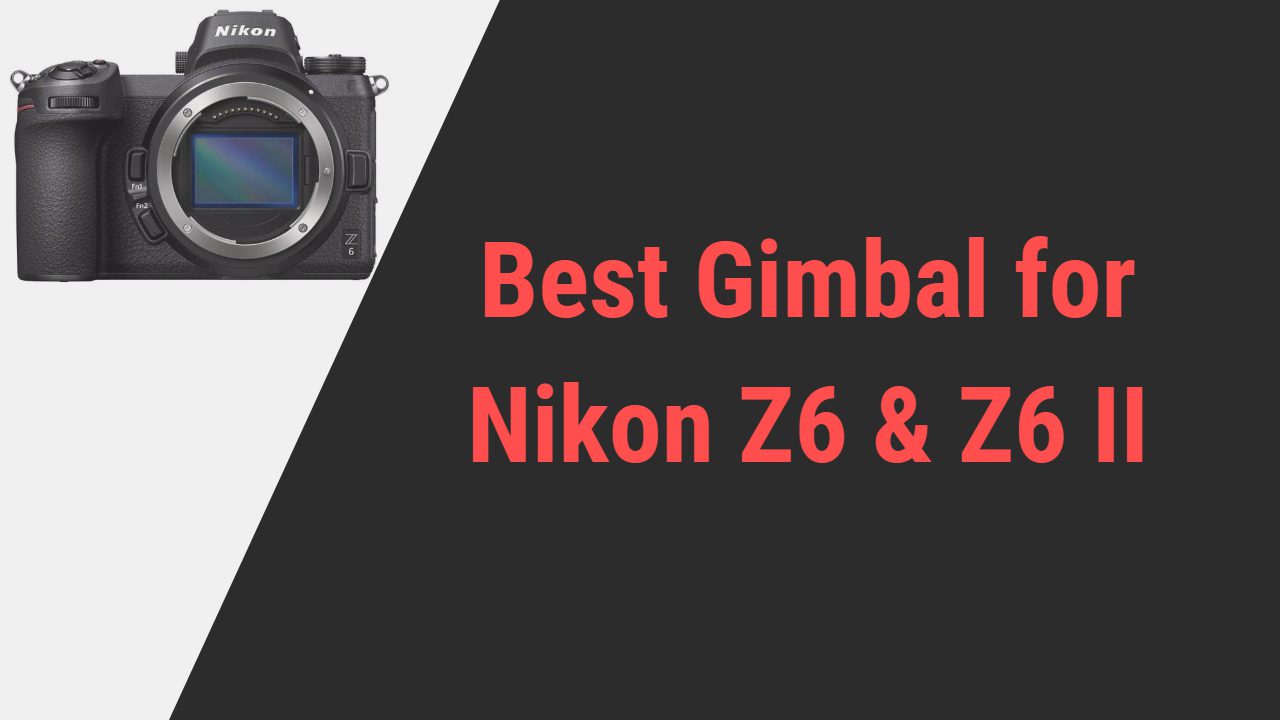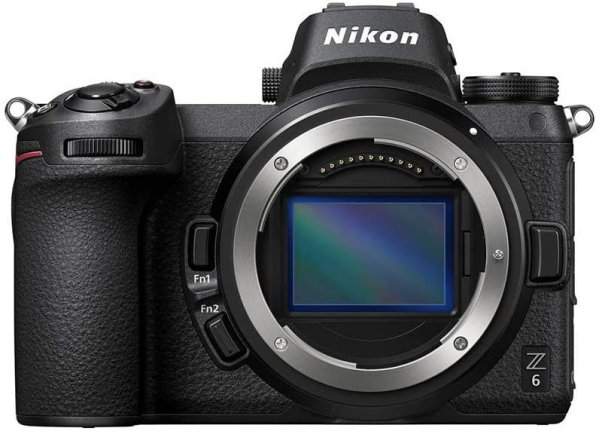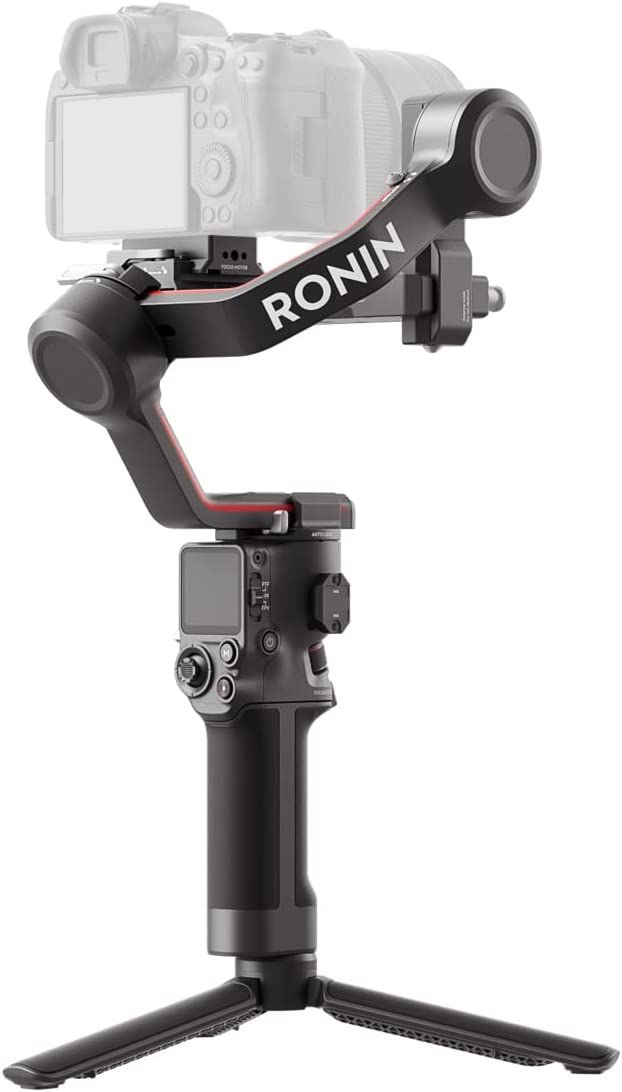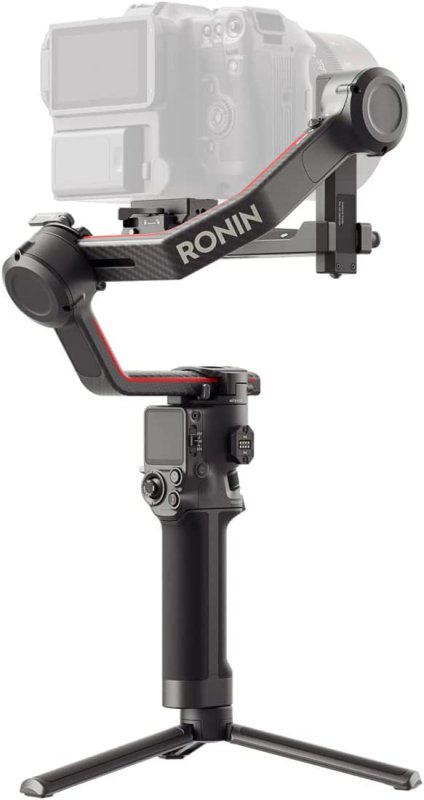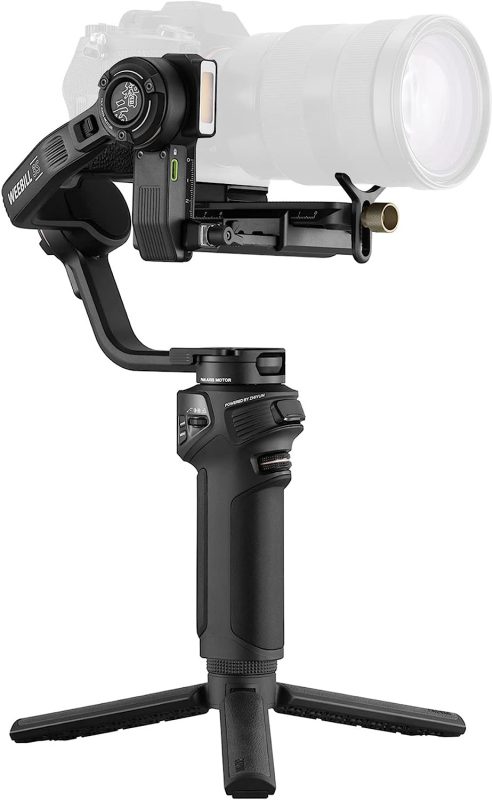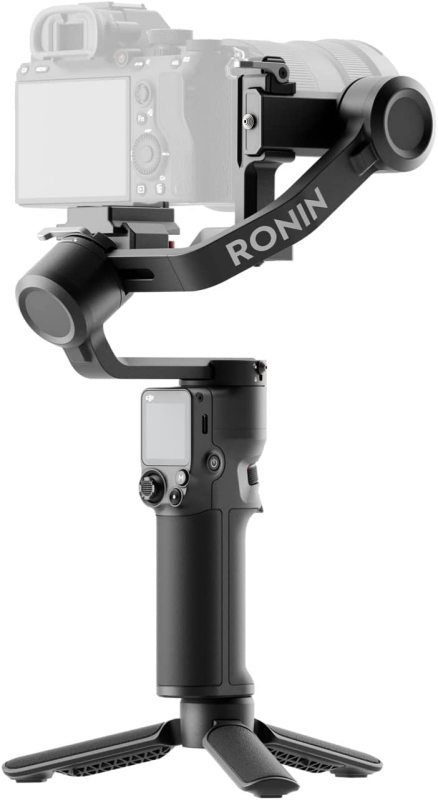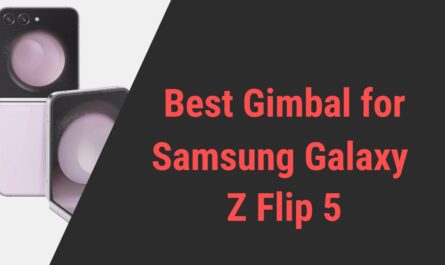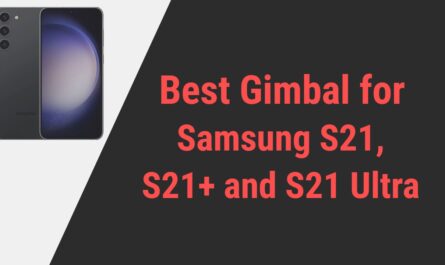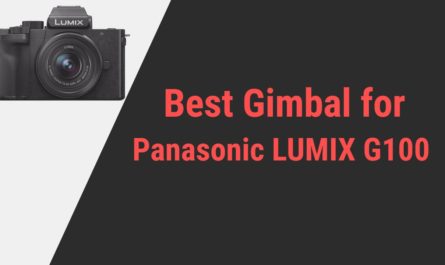Nikon is one of the most iconic brands in the photography world, and if I may add, one of the most trusted and loved brands, too. Among Nikon’s greatest inventions, the Nikon Z6 and its mighty successor, the Z6 II, have their charm when it comes to professionalism in photography.
If you own these beauties, you will know how wonderfully creative these two advanced cameras can get, capturing the joy of every moment with unrivaled clarity. But wait, have you ever felt that missing piece of the puzzle? The stabilization.
Note:
All the gimbals mentioned here are tested with Nikon Z6 and Z6 II and work perfectly fine.
| DJI RS 3 (Best Overall)
     |
| DJI RS 3 Pro (Most High-end - Highest Payload Capacity & Comes with Advanced Features)
     |
| Zhiyun Weebill 3S (Budget Pick)
     |
| DJI RS 3 Mini
     |
For people who don’t know much about it, gimbal is an innovative piece of creation that works to sabotage every moment caught during dynamic shooting and makes footage cinematically smooth, steady and full of artistic.
So today, we will be exploring the realm of gimbals for our Z6 series camera. Get ready; whether you are a seasoned photographer or a beginner, buckle up for a tantalizing journey of finding the perfect stabilizer companion, the best Gimbal for Nikon Z6 and Z6 II that can turn your footage into an out-of-the-world clear and steady shot, one beyond the ordinality.
Best Gimbals for Nikon Z6 and Z6 II
1. DJI RS 3 3-Axis Gimbal for Nikon Z6 & Z6 II Cameras
To be honest, I have never seen anything like the Nikon Z6 and Z6 II, and this wonderful DJI RS 3 has combinedly elevated my filmmaking experience like never before.
The shades of stabilization RS 3 delivers are something beyond extraordinary, and this is probably why it is the brand’s best-seller.
Highlight– DJI RS 3 from the house of reliable DJI brand came up with effortless compatibility with both my cameras, Z6 and Z6 II. The gimbal is trained to carry about 6.6 pounds when its own weight lies somewhere around 2.2 pounds.
The built-in 3000 mAh lithium-ion battery of the gimbal smartly guarantees about 12 hours of runtime with 2.5 hours of quick charging.
Features–
Redesigned with the inspiration to be lighter and sleeker than ever, DJI RS 3 is bliss to every cinematic photographer out here. If we start with the basics, the gimbal is easy to connect with my Z6 series, courtesy of dual layered quick-release plates, making things fast and convenient.
To secure all the axes and add cinematic flair to the footage as well, the gimbal plays to encourage the right usage of axis locks.
The body of RS 3 is a charm with a secure grip and stylish character; the barrel is engraved with some basic yet essential dials to engage in the settings and controls without interrupting the operation.
This might include the fine-tuning knob, the camera mode switching slider, or the basic front dial.
But that’s nothing compared to what remote control can do: one interaction with the DJI official application. And Boy! What a creative world it approaches in front of us.
There is no lack of artistic aspect with the gimbal; it is well-experienced in shooting multiple follow, motion functions, and other effective modes, one that can wonderfully transform your footage into a masterpiece.
If we talk about its core, the high-quality stabilization, I would definitely want to bring its next-generation upgraded Third-gen RS stabilization one that approached about 20% enhanced steadiness over every shot.
Rest is taken care of by the Super Smooth mode, which has the power to increase motor torque. There are some creative functionalities of the RS 3, like the wider 1.8 OLED panel or live transmitting at 1080p, that makes it stand out among all.
In a word, A wonderfully worthy buy!!
Why should you buy it?
- Additional super smooth
- Largest OLED-colored panel
- 1080p image transmission
- Durable battery life
- Creative motion function shooting
- Easy mount and axis lock
- Light and compact body
Why should you avoid it?
- Takes forever to recharge
- Not strong enough
2. DJI RS 3 Pro 3-Axis Handheld Gimbal Stabilizer
Being a little greedy, I moved on to an upgraded version, DJI RS 3 Pro, and this marvelous gimbal goes beyond my expectations to fulfill all my artistic aspirations.
What an impression It did throw with its impeccable versatility and the layer of professional expertise with promised durability. Just add spices to the whole dish.
Highlight– Upgraded with more power hunger, DJI RS 3 Pro holds an exceptionally heavy payload capacity of 10 pounds weight, enough for Z6 and Z6 II with all its accessories.
Supporting 2.4 GHZ Wi-Fi and 5.0 Bluetooth, it collaborates with cameras and smartphones for easy control. 2.5 pounds weighted RS 3 Pro grants 12 hours of the same runtime but with the quickest 1.5 hours of recharge
Features–
Beyond all its technical exceptions, there comes versatility. If we compare RS 3 Pro with RS 3, we will find some similarities as well as differences.
Talking about similarities, RS 3 Pro also encourages easy mounting with dual-layered quick-release plates, and the same goes for the automated axis locks securing the Z6 camera while on a crazy creative adventure.
RS 3 Pro is also considered to be the master of stabilization; empowered by the third-generation RS Stabilization, it does some wonderful stability magic over every shot, enhancing its quality and value; the same goes for super smooth mode.
Again, the upgrade in RS 3 Pro brings this idea of having quality stability for extensive scenarios with the help of DJI RS SDK protocol.
The creativity games keep on shining; all the artistic modes POV, Lock, Follow, Time Lapse, Panorama, and countless other creative modes can be embraced with RS 3 Pro with ease.
In addition, the gimbal does have this excellent Active Track Pro one that keeps an eye on the subject no matter when it leads or even jumps out of the frame for that focused shot.
Focus reminds me of the RS 3 Pro’s ability to support LiDAR focusing technology, where using the LiDAR range finder can project multiple ranging points, making focusing more effective and entertaining.
There are additional ports added to the design of RS 3 Pro, making a way to connect to different accessories like dual handles and briefcase handles for added flexibility.
Following the footsteps of RS 3, the Pro also indulges in seamless control and handling with its all-engraved dials with customizable basic settings and remote control via the DJI application.
What is different is the build of the gimbal with the carbon fiber grade composite RS 3 Pro, trying to put on more durability while sticking to minimal weight to offer comfort and safety together.
In a word, A High-end stability beast; Must buy!
Why should you buy it?
- Exceptional durability
- Upgraded Active Track Pro
- Extensive coverage
- Largest display panel
- Unique LiDAR compatibility
- Quickest recharging
- Added accessories ports
- Excellent payload
Why should you avoid it?
- Expensive than alternatives
- Larger and bulkier
3. Zhiyun Weebill 3S Gimbal Stabilizer for Nikon Z6 & Z6 II
Now, in order to make me explore and embrace the depth of stability with Nikon Z6 and Z6 II, I cross my path with the Weebill 3S, the smartest of all gimbals with exceptional beauty features, top-notch innovation, affordable price range, and exquisite durability.
The gimbal allows me to adapt to different shooting scenes with ease and professionalism.
Highlight– Encapsulating ravishing functionality, Weebill 3 has the potential to merge with Z6 and Z6 II cameras, promising seamless control with updated 2.4 GHz Wi-Fi and 5.0 Bluetooth.
While the brand does not disclose its payload capacity, it behaves gently and comfortably with my Z6 series camera weighing at least 2.4 pounds.
Then the battery, integrated with two Lithium-ion batteries charged to 2600 mAh, offers an extended 11.5 hours of working with 2 hours of recharging.
Feature–
Well, I generally don’t trust my precious Z6 and Z6 II with any gimbal, but there is something wonderfully special about Weebill 3 S. Let’s start with its first impression.
The gimbal has this stunning appearance with a strong vibe reflecting the body, but the ergonomics it offers is something extraordinary.
An extendable sling grip for better handgrip, an additional wrist rest to nourish your hand’s health, and a sling mode for the low-angle shot are something to die for.
Then, there is stabilization, the main business, if you say. So, the gimbal comes with an updated 10th-generation stabilization algorithm, which is precise enough to sabotage unnecessary movement and provide cinematic flair in your visuals.
This quality stabilization works in any scenario, any angle, and any mode, which reminds me of the collection of shooting modes Weebill 3 S has in its pocket.
You can play with time and motion to showcase your skill in time-lapse, hyper-lapse, and panorama-like modes or master your professionalism in cinema by delving into multiple follows like lock, POV, and follow mode.
Switching between these modes or interacting with any setting is easy as pie, and so is the seamless collaboration with my Z6 and Z6 II, with no hassle at all.
The Zhiyun official application took care of connecting the camera and gimbal to my phone in order to embrace easy controlling, while the easy, quick release is why I don’t feel a thing while tucking my camera on the gimbal or switching orientation like horizontal or vertical for content creation, that’s the plus.
Last, certainly the best, the gimbal also comes with an in-built Fill light. This feature is put together to enhance the quality of the image.
So, the customizable built-in light with adjustable color temperature secures a strong color cast and high resolution, saving some unbelievably dazzling shots.
In a word, it is The ultimate stabilization weapon for innovators!
Why should you buy it?
- Sling and Stylish body
- Additional Hand grip and west rest
- Updated stabilization
- Customizable Fill light
- Strong battery hold
- Trans mount Live transmission
Why should you avoid it?
- User reports limited payload
- Not a very long-lasting build
4. DJI RS 3 Mini 3-Axis Mirrorless Gimbal for Nikon Z6 & Z6 II
RS 3 and Pro were impeccable gimbals with stunning functionality; however, being a keen traveler myself, I was looking for the same taste of power in a more compact version, and there I met the DJI RS 3 mini version, the perfect companion for the on-go photography with endless creativity and stable cinematic vibe.
Highlight– Following the more compact but more creative vision, RS 3 Mini bears the ability to carry a maximum of 4.4 pounds of payload, tackling the weight of Z6 and Z6 II lenses and accessories, sticking to a feather-like weight of 1.9 pounds only.
Being a DJI’s exception, it blends in with the working of both cameras effortlessly while the artistic stability operation lasts for 10 hours straight on a single charge with the courtesy of one strong 2450 mAh Lithium-ion battery.
Features-
As I might have mentioned, the RS 3 Mini is the compact version of the beastly power of the DJI RS gimbal series. This is why the body of the gimbal is designed with a single-handed grip with enhanced ergonomics to make it a fine on-the-go gimbal choice.
The least weight adds the icing on the cake, but that doesn’t compromise on what the gimbal stores in its versatility plate.
The gimbal also includes several additional ports to add any accessories you want to add, like a hand grip or briefcase handle, but not that it will be needed because RS 3 Mini is excellent in shooting low angle.
Then, the detachable tripod one that comes for added stability and also works as an extended grip for extra comfort.
Do not misunderstand that if any gimbal such as a compact as RS 3 Mini does not follow the durability factor, no, this one is firm with a robust build and secure enough to handle your Z6 series and its accessories.
Mounting and balancing the cameras was never a challenging task. With the simple push of dual-layered quick-release plates, your setup is ready without the struggle of rebalancing and all that weird stuff.
Once you get it all set, the real deal starts the shooting in different modes at different angles, manipulating time and motions or simple subject tracking everything that can make the footage stand out.
One thing that caught my eye is RS 3 Mini is designed to help beginners or vloggers, which is why it is a great skill in social media content shooting, specifically in switching between horizontal and vertical modes.
It all might sound a little overwhelming to you: the calibration, the mode switching, the gimbal movement adjustment, but trust me, it’s not. With the helping hand of the DJI application and some barrel dials, controlling the gimbal is a cakewalk.
In a word, it is A convenient, creative key for cinematic shots!
Why should you buy it?
- Compact with foldable body
- Dedicated to content creation
- Light as feather
- Included OLED panel
- Additional Accessories mounts
- Included detachable tripod
Why should you avoid it?
- Fluctuate with heavy-weight
- Not much reliable battery
Tips for maximizing Nikon Z6 and Z6 gimbal efficiency
Nikon’s wonderland of the advanced camera goes beyond, and its Nikon Z6 and Z6 II, with their powerful imaging capabilities, stunned me enough until I came across the right pair of gimbals.
After pairing them with the right gimbal, their incredibility is unexplainable. Moreover, you should know that no matter if you are an expert or just entering the photography world, optimizing tricks for your gimbal can never do harm.
So here are some primary tips that will help you harness the creative power of Nikon Z6 and Z6 II and their gimbal exceptionally.
Buying– Start your journey by buying the right gimbal for your Nikon Z6 and Z6 II. Now, this shouldn’t be a quick peak and pay choice. There are some serious considerations you need to follow. Check whether your to-be gimbal is compatible with Z6 and Z6 II mounts and configurations. Determine whether its payload capacity satisfies Z6 weight or not. Then, take a quick peek at its additional features like battery life, durability, portability, creativity, controls, and price.
Setting– Once you have got your hands on the ideal gimbal, take time to get to know it, briefly read through its manual and setup process, and follow the manufacturer’s instructions to set the gimbal. Keep your cautious eye open during the proper installation of gimbal on your Z6 or Z6 II because this is that significant foundation factor that leads to optimal performance throughout
Balancing– Once you have your camera on, it is time to balance the little creative thing. Knowing that achieving balance is vital for smooth and stable footage as well as operation. So, invest your effort and time in making sure your camera is properly balanced on the gimbal. You may use fine-tuning through the gimbal’s application for the camera positioning and always check all the axes before ensuring an even weight distribution.
Using– Now comes the main part, the usage. This is the most fascinating part, where you get to take a dive into the ocean of various shooting modes and functionalities that a gimbal has to offer. You can experiment with different follow modes, play with intelligent motion function features, and learn every artistic potential the gimbal holds and adapt to in different scenarios. There are other manual modes you can try to enhance your creative expression.
Maintaining– Once you are done pouring the infinite creativity into your shot, you should pamper your gimbal. Regular maintenance ensures the longer efficiency of your gimbal. For the best maintenance of your gimbal, cleaning them as much as needed is necessary. Keeping an eye on the motor or not overloading the gimbal plays a vital role. You can also check for firmware updates for any latest feature upgrades, and you should store your gimbal somewhere safe when not in use.
Know a little about your cameras: Nikon Z6 and Z6; Characteristics and Differences
The design house of Nikon has been cooking the greatest of all-time cameras for quite a long time; the Nikon Z6 and its successor Z6 II are known to be the brand’s top-notch service reflection.
These two exquisite cameras embody the true symphony of cutting-edge technology, convenience, and creative powers in the whole world of full-frame mirrorless cameras.
The brand’s commitment to delivering a tool with unparalleled imaging experience and stunning videography is fulfilled by these two inventions.
Both of these cameras have a sophisticated design and physics to die for, but Z6 II, being an upgraded version of Z6, does have its comparative nuances. Let’s find out what improvement the Z6 II, an upgraded camera, has to offer relatively Z6 expertise.
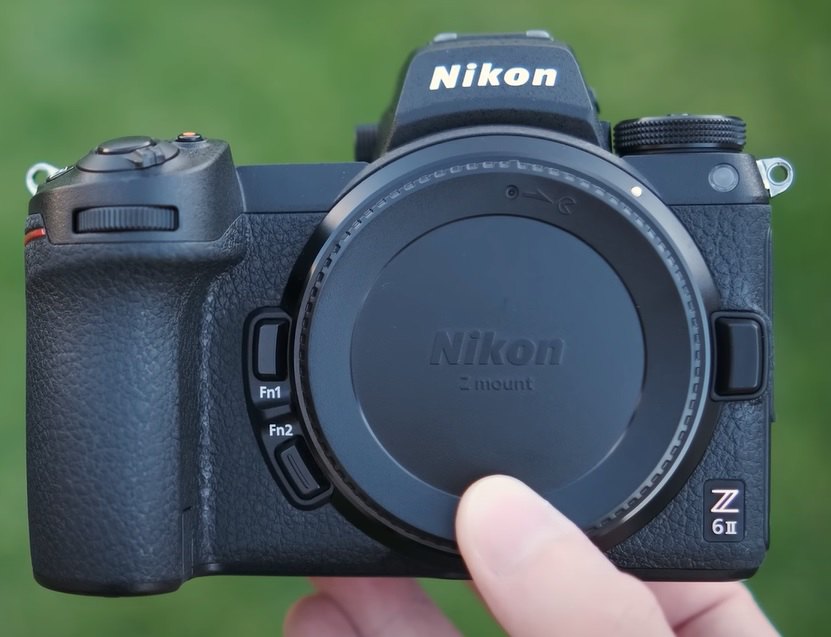

General– Nikon Z6 was introduced by the brand on 23 August 2018, while Nikon Z6 II was announced on 14 October 2020
Sensor– Both Nikon Z6 and Z6 II cameras come with a high-end 24.5-megapixel full-frame sensor for clarity-enriched still shooting.
Image Processor– Z6, as previously launched, comes with a precise and fast EXPEED 6 processor, while Z6 II boasts an upgraded, faster dual EXPEED 6 processor
Videography– Z6 comes with flawless video shooting, supporting 4K filming at 60 frames per second, while Z6 II, with improved capabilities, shoots 4K at 30 fps.
Focusing– Z6 works great with a hybrid focusing system, but Z6 II with dual processors is a faster and more accurate focusing supporter with subject tracking.
ISO – Both cameras are excellent at shooting low light performance, with an ISO range of 100-51200 extendable to 50-204800.
Shutter Speed– With the mechanical focal plane shutter and electronic rolling shutter, Z6 manages continuous shooting at 12 fps while Z6 II manages shooting at 14 fps.
Viewfinder– Both of the cameras feature built-in electronic 0.5 inched viewfinder with 3.6 million resolution and 0.8x magnification
LCD Panel– Both the Z6 and Z6 II camera has an intuitive tilting LCD screen with finger touch sized 3.2 inches with 210K dot resolution
Stabilization & Storage– Both the cameras Z6 and Z6 II have the inclusion top-notch five-axis in-body image stabilization, and both have dual memory card slots
Battery– Both of the cameras come with the strongest Lithium-ion battery that can be recharged, guaranteeing about 350 shots on a single charge
Weight– Both of the cameras have the strongest and most stylish physics composed of high-graded Magnesium alloy composite, but the Nikon Z6 weighs about 1.29 pounds while the Nikon Z6 II weighs 1.4 pounds
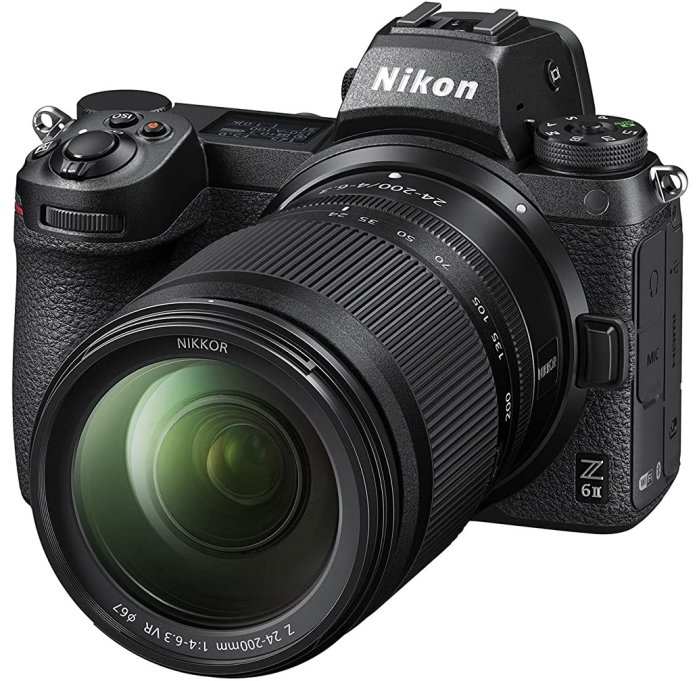

Frequently Asked Questions (FAQs)
Q. Can I use a smartphone gimbal for a mirrorless camera?
Well, no, you cannot use a smartphone gimbal for your mirrorless camera. Generally, smartphone gimbals are designed with specific potential for certain dimensions and weights of smartphones, and mirrorless cameras certainly don’t satisfy that.
This is the reason smartphone gimbals are not capable of providing the necessary support for the larger and heavier body of mirrorless cameras.
Camera gimbals are designed with a stronger motor, robust build, and potential to accommodate advanced camera weight as well as the additional weight of its accessories. Only such gimbals can ensure optimal stability and performance for your mirrorless camera setup.
Q. What features should I look for in a gimbal for the Nikon Z6 series?
Selecting the ideal Gimbal for the Nikon Z6 or Z6 II series is quite the trickiest part; you have to rely on some essential features that define the character of your To-be gimbal.
First of all, check the gimbal payload capacity, stabilization technique, and strength, and consider the portability factor and ergonomics. Do not forget to keep an eye out for the strongest power support and longer runtime.
Make sure the gimbal you are considering follows user-friendly controls or optional smartphone integration and the gimbal does have creative shooting modes versatility.
Above all things, you need to make sure the gimbal you are choosing should be compatible with your Z6 and Z6 II.
Q. What is the role of motors in a gimbal?
In simpler words, it is all a game of motors; Gimbal’s motor plays a vital role in stabilizing your camera during dynamic shooting. Encouraging the operation on three axes, the motor recognizes and later suppresses any slightest movement caught during shooting, keeping your footage flawless.
The motors of gimbals act as the powerhouse, encouraging the necessary stability, smoothness, and image enhancement to transform potentially shake shots into captivating stories without approaching much effort or hassle.
Wrapping up
And there you have it, the ultimate list of some best of all gimbals for your Nikon Z6 series and a brief buying guide about the camera and gimbal itself. Thus, here, the journey meets its end.
In a short recap, I have introduced my personal experience and versatility, enriched four Gimbals that suited best for both Nikon Z6 and Z6 II cameras and harnessed their power to let them all shine in cinematic glory. Which of these will be your choice, then?
Don’t worry if you want to explore more options; there are plenty of fish in the sea, so all you have to do is mark down some significant factors of any gimbal you want to buy, such as its compatibility, its versatility, its performance, its convenience, its strength and durability and price budget and voila you have gotten yourself the ideal Gimbal for Nikon Z6 and Z6 II.
So, what’s stopping you now? Run along to the blank canvas of the world and create a stunning visual shot with the best Gimbal for Z6 and Z6 II and leave an indelible mark on your audience.
Happy Filming!

